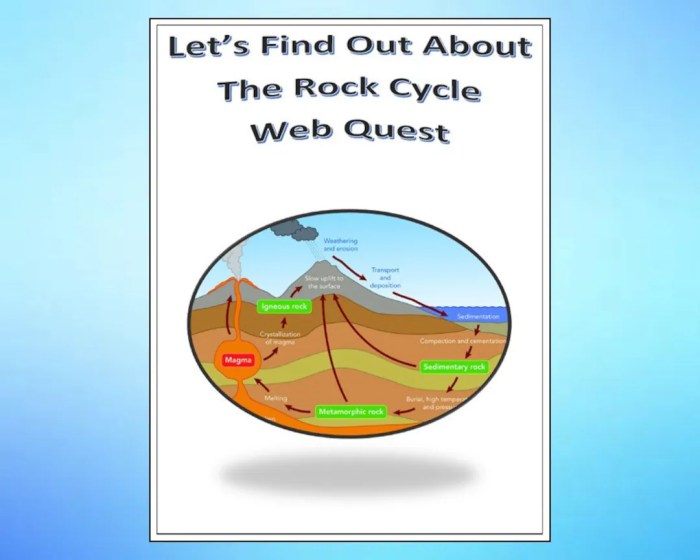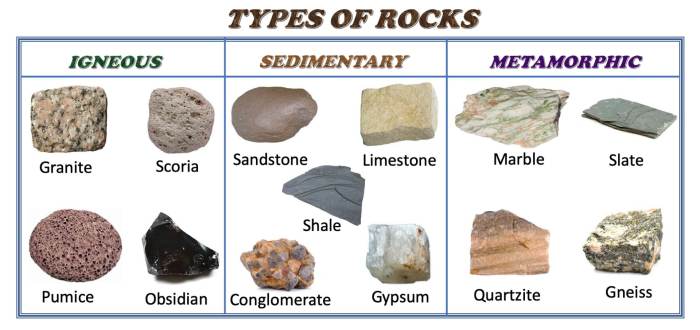Embark on a captivating exploration with the Rock Types & Rock Cycle Webquest, where the secrets of the Earth’s geological history are unraveled. This comprehensive guide delves into the diverse world of rocks, their formation, and the continuous cycle that shapes our planet’s surface.
From the towering mountains to the depths of the ocean, rocks hold a wealth of information about the Earth’s past, present, and future. By understanding rock types and the rock cycle, we gain invaluable insights into the dynamic processes that have shaped our planet and continue to influence its evolution.
Rock Types: Rock Types & Rock Cycle Webquest

Rocks are solid aggregates of one or more minerals. They are classified based on their composition and formation. The three main types of rocks are igneous, sedimentary, and metamorphic.
Igneous Rocks
Igneous rocks form when magma or lava cools and solidifies. They can be classified into two main types: intrusive and extrusive. Intrusive igneous rocks form when magma cools slowly beneath the Earth’s surface, while extrusive igneous rocks form when lava cools quickly at the surface.Examples
of igneous rocks include granite, basalt, and obsidian. Granite is a coarse-grained intrusive rock that forms from the cooling of magma deep within the Earth’s crust. Basalt is a fine-grained extrusive rock that forms from the cooling of lava at the Earth’s surface.
Obsidian is a volcanic glass that forms from the rapid cooling of lava.
Sedimentary Rocks
Sedimentary rocks form when sediments, such as sand, silt, and clay, are compacted and cemented together. Sediments are transported by wind, water, or ice and deposited in layers. Over time, these layers are compacted and cemented together by minerals to form sedimentary rocks.Examples
of sedimentary rocks include sandstone, limestone, and shale. Sandstone is a rock composed of sand grains that have been cemented together. Limestone is a rock composed of calcium carbonate that has been precipitated from water. Shale is a fine-grained rock composed of clay minerals that have been compacted and cemented together.
Metamorphic Rocks
Metamorphic rocks form when existing rocks are subjected to heat and pressure. Metamorphism can occur when rocks are buried deep within the Earth’s crust or when they are in contact with hot magma.Examples of metamorphic rocks include marble, slate, and gneiss.
Marble is a rock that forms from the metamorphism of limestone. Slate is a rock that forms from the metamorphism of shale. Gneiss is a rock that forms from the metamorphism of igneous or sedimentary rocks.
Rock Cycle

The rock cycle is a continuous process through which rocks transform from one type to another. The rock cycle is driven by geological forces, such as heat, pressure, and weathering.
Stages of the Rock Cycle
The rock cycle consists of four main stages: weathering, erosion, deposition, and metamorphism.Weathering is the process by which rocks are broken down into smaller pieces. Erosion is the process by which these smaller pieces are transported by wind, water, or ice.
Deposition is the process by which these smaller pieces are deposited in layers. Metamorphism is the process by which these layers are subjected to heat and pressure to form new rocks.
Geological Forces, Rock types & rock cycle webquest
The rock cycle is driven by a variety of geological forces, including heat, pressure, and weathering. Heat can cause rocks to melt and form magma. Pressure can cause rocks to fold and deform. Weathering can cause rocks to break down into smaller pieces.
Detailed FAQs
What are the three main types of rocks?
Igneous, sedimentary, and metamorphic rocks
How does weathering contribute to the rock cycle?
Weathering breaks down rocks into smaller particles, which can then be transported and deposited, forming sedimentary rocks
What is the role of metamorphism in the rock cycle?
Metamorphism transforms existing rocks into new types of rocks under conditions of intense heat and pressure